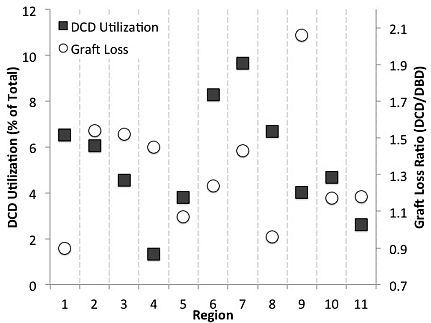Geographic Heterogeneity in Use and Outcome of DCD Livers
Scientific Registry of Transplant Recipients, Minneapolis Medical Research Foundation, Minneapolis, MN
Gastroenterology, Mayo Clinic, Rochester, MN
Surgery, University of California San Francisco, San Francisco, CA
Meeting: 2013 American Transplant Congress
Abstract number: D1636
Background/Aim: Donation after circulatory death (DCD) liver transplants (LTs) are increasingly performed due to organ shortage. Graft survival rates for DCD LTs are inferior to rates for donation after brain death (DBD) LTs. With a long-term goal of defining best practices in DCD LTs, we compared differences in regional use and subsequent graft outcomes of DCD and DBD LTs.
Methods: Using the SRTR database, we identified all adult deceased donor LTs, 2004-2011. Multiorgan transplants were excluded. The primary analysis calculated the risk ratio of graft and patient survival between DCD and DBD LT. Cox regression analysis adjusted for relevant recipient, donor, and transplant characteristics.
Results: During the study period, 2,007 DCD (4.8%) and 39,264 DBD LTs met inclusion criteria. DCD recipients were more likely to be older (mean age: 55.1 vs. 53.7 years) and non-status 1 (% status1: 3.2% vs. 5.5%), with lower MELD scores (mean: 23.0 vs. 25.1). One-year graft survival was 78% for DCD and 85% for DBD. Corresponding 1-year patient survival was 86% and 88%. Nationwide, DCD was associated with 1.34 (95% CI=1.19-1.50, p<0.001) times greater risk of graft failure than DBD. The relative risk of death was 1.15 (95% CI=1.00-1.33, p=0.046). The highest proportion of DCD LTs was in Region 7 (9.7%) and the lowest in Region 4 (1.3%, p<0.001 for regional difference). The risk ratio of graft failure for DCD vs. DBD ranged from 0.90 (95% CI=0.51-1.58) for Region 1 to 2.06 (95% CI=1.52-2.77) for Region 9. There was no apparent correlation between use and graft outcome by region (p=0.619).
Conclusion: There are large differences in use and outcome of DCD LTs by region, with no correlation between the two. Reducing geographic disparities by adopting best regional practices in selection and use of DCD organs may optimize the overall LT outcome.

To cite this abstract in AMA style:
Kim W, Stock P, Xiong H, Liu J, Schladt D. Geographic Heterogeneity in Use and Outcome of DCD Livers [abstract]. Am J Transplant. 2013; 13 (suppl 5). https://atcmeetingabstracts.com/abstract/geographic-heterogeneity-in-use-and-outcome-of-dcd-livers/. Accessed December 8, 2025.« Back to 2013 American Transplant Congress
